Abstract
Extension programs are most effective when informed by a deep understanding of the target audience. To guide programs in Florida's managed landscapes, especially pertaining to water quality and conservation, faculty from the UF/IFAS Center for Land Use Efficiency (Previously Center for Landscape Conservation and Ecology) conduct an annual statewide survey. The survey gathers data that includes common landscape elements, neighborhood characteristics, engagement in irrigation and fertilizer best practices, perceptions surrounding conservation, and learning preferences. This publication presents highlights from the 2018 statewide survey with recommendations for how to use the information. This document was developed for Extension professionals and others who work on landscape, horticulture, and water issues.
How to Use This Information
Extension professionals and other practitioners who work on landscape and water issues can use this information to meet the needs of their target audiences. They should consider:
- Focusing on behaviors with lower levels of adoption. It is clear that some behaviors are relatively common on a statewide scale while there is great potential to promote others. Extension professionals might consider promoting those practices that few individuals currently use, when they are appropriate for their target clientele.
- Focusing on behaviors that have the greatest potential impact, when potential for adoption and expected impacts are quantified together (see AEC712, Strategically Selecting Behaviors that Impact the Problem: An Approach Drawn From Social Marketing, for more discussion of this concept). For example, when considering multiple water conservation practices, the expected quantity of water that may be saved by current nonadopters can be used to compare behaviors. There are currently a number of metrics that can be used to estimate potential impacts (e.g., see FE1009, Estimating Benefits of Residential Outdoor Water Conservation: A Step-by-Step Guide, for examples of quantifying water conservation practices. Look for more in the near future as a result of ongoing work to identify new metrics and quantifiable impacts).
- Integrating less-used behaviors with those having high levels of adoption. When teaching about those practices Extension clientele are comfortable with, consider highlighting the compatibility of less-used practices.
- Using these findings as a starting point for local programs. The practices reported here can be used to conduct a needs assessment with local Extension audiences. An Extension professional might consider collecting information to see if the use of these practices is consistent with the average use across the state.
Additional recommendations are shared in each of the following sections.
Collecting Statewide Data on Floridians' Landscapes and Management Practices
The data presented in this document are part of an annual statewide survey used to collect information about Floridians' landscape practices and perceptions. The annual sample is collected through a professional survey sampling company and the survey is administered electronically. Participants must have been 18 years of age or older and residents of the state of Florida to take the survey. In 2018 we gathered data from 3,596 Florida citizens.
Questions gathered data about features of Floridians' lawns and landscapes, whether they hired professionals for any services, the structure of their homeowners' association (HOA) and its policies, and which water conservation and fertilizer best practices they engaged in. To keep the survey length short, the 3,596 respondents were randomly assigned to answer questions about either water conservation or fertilizer practices.
In an ideal situation we would have accessed a random sample of all Floridians. Because this was not possible, we targeted a sample that matched some characteristics of Florida as whole, as indicated by the 2010 US Census. To further ensure the data were representative of the population, we weighted individual responses using sex, age, race, ethnicity, and whether the county was urban or rural (Lamm & Lamm, 2019). In a nonweighted dataset, each response counts as one response. However, in a weighted dataset, responses from people in underrepresented groups count for more than one, while those from overrepresented groups count for less than one.
HOA Characteristics
In Florida, a lot of people live in communities with HOAs; in our study this was about half of respondents (n = 1,691; 47%). In fact, Florida leads the country in both numbers of HOAs and number of people living in communities with HOAs (CAI, 2017a, 2017b). Three out of four of those who have an HOA have policies related to their landscaping (and probably more, because some people were not sure). About two-thirds of those with HOAs say their HOA imposes penalties such as fines for the look of residents' landscapes, while only one-fifth indicated there are opportunities to receive positive recognition for the look of their landscape.
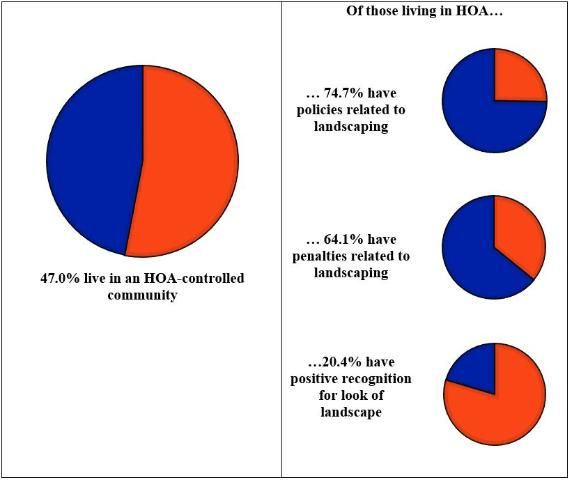
These results show that many Floridians are subject to a lot of requirements and rules, which is an important consideration for delivering programs. When promoting landscape best management practices, it is important to ensure compatibility with existing regulations and rules.
Common Features Present in Floridians' Yards
Respondents were asked to indicate all of the features and plant material types they had. Lawns, shade trees, and palm trees were the most common landscape features. Just over one-fourth indicated they had a vegetable garden, and fewer said they have fruit trees or pollinator plants.
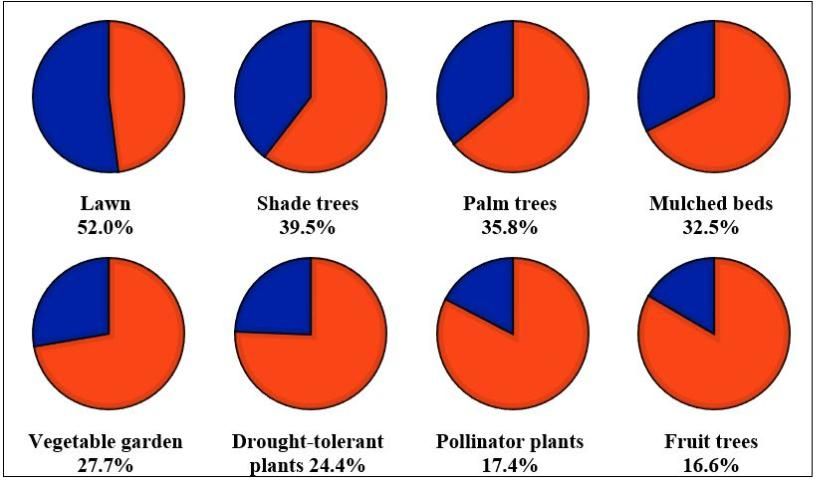
Hiring Professionals
Respondents were asked to indicate what practices they or their HOA hired a professional for. Lawn maintenance was the most common category. While 20% said they did not use a professional for any service, 80% used a professional for at least one task. The most common tasks were lawn maintenance (34.1%), pest management (24.5%), fertilizer application (23.9%), tree pruning (23.2%), and weed management (20.1%).
While the use of professionals is not especially high for any of these categories, it shows most Floridians are using professionals for at least one landscape task. Following this finding, Extension professionals should consider that these professionals do, or could, play a role in educating Extension clientele. Extension can extend our reach by ensuring these professionals have the most up-to-date information available. Further, we can help Extension clients learn to ask for services that align with landscape best practices following the most current science.
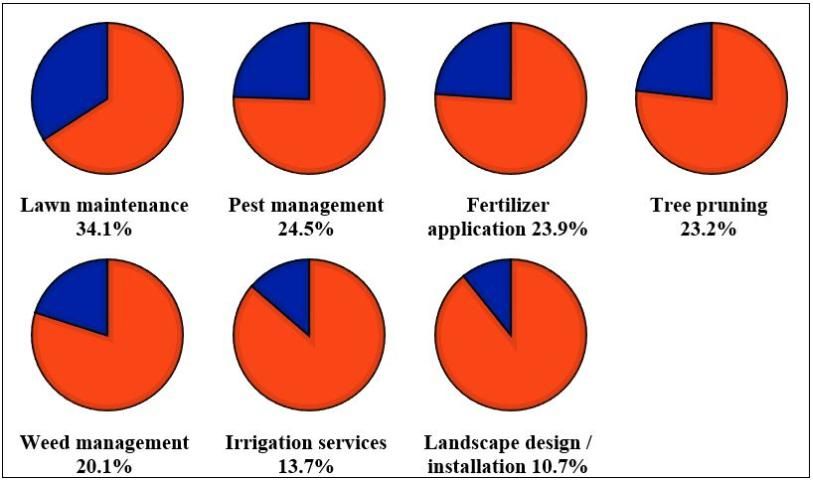
Water Conservation Practices
Respondents were asked if they used specific practices to save water in their home lawn and landscape, and they were provided the opportunity to indicate yes, no, or not applicable. The graph below presents the percentage of those who indicated yes to each practice. Less than half of respondents answered yes regarding nearly every practice. Drip irrigation (14.6%), rain barrels (15.9%), and smart irrigation (17.1%) were the least commonly used practices. About half of respondents (50.2%) indicated they seasonally adjusted their irrigation times. The most common practice was having drought-tolerant plants in the landscape (65.2%).
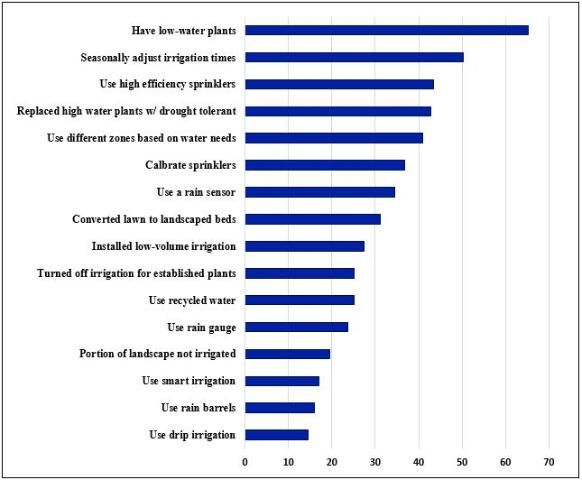
Note: Percentage indicates those who indicated yes to using each practice out of those who indicated the practices were applicable and who were randomly assigned questions about irrigation use (n = 1,187). Individuals who indicated a practice was not applicable were not included in calculating percentages for the specific item.
Those practices and technologies that are least used represent opportunities to encourage new water-saving strategies. Those that are most used represent practices Floridians are most comfortable with, and they could serve as gateway practices with which to introduce new and less-used technologies. When reviewing the data, we considered there is a chance that some people may not know what certain practices or technologies are (e.g., smart irrigation), further highlighting a potential opportunity to promote less-known practices.
Fertilizer Best Practices
Respondents were asked if they used specific fertilizer best practices in their home lawn and landscape. Responses include never, rarely, sometimes, often, and always. The graph below presents the percentage of those who indicated they engage in a practice often or always.
Floridians are least likely to make sure a hired professional has GI-BMP certification (27.7%) or otherwise ask about a professional's training to apply fertilizer (28.0%) and to test their soil to determine whether fertilizer is needed (17.8%). There is a great opportunity to educate the public on the professional training available for people who apply fertilizers and the value of hiring GI-BMP certified professionals. Extension professionals should empower clientele to learn to ask about training credentials and also have conversations about fertilizer selection, timing, and rate. Fertilizer professionals can also play a role in educating the public. For example, the GI-BMP program is currently developing strategies to promote the use of trained professionals (for example, generating an invoice stuffer that fertilizer professionals can use to educate the public on the value of hiring a trained professional, while providing landscape recommendations for each month).
Another great opportunity for Extension professionals and other service providers includes performing or facilitating soil tests and using the results as educational tools. While soil tests are part of many Extension programs across the state, (see the UF/IFAS Extension Soil Testing Laboratory (ESTL); https://soilslab.ifas.ufl.edu/) there is a significant opportunity to reach more Floridians with this service. Soil tests could be part of a suite of services offered through office consultations or site visits (along with inspecting for pests, checking the irrigation system, and taking a soil sample). There are also opportunities to promote the availability of soil tests in new ways.
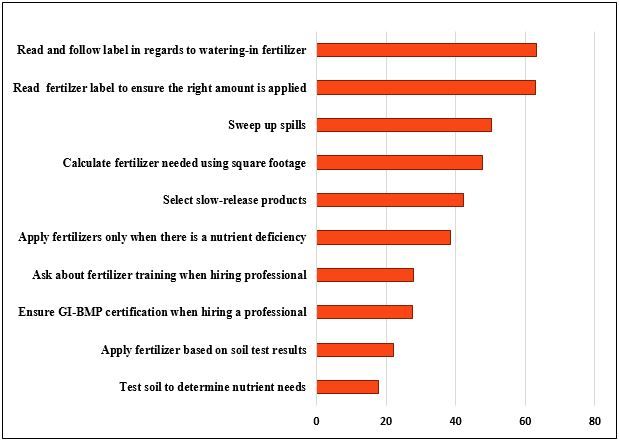
Note. Percentage indicates those who always or often engage in the practice out of those who indicated the practices were applicable and who were randomly assigned to answer questions about fertilizer use (n = 1,170). Individuals who indicated a practice was not applicable were not included in calculating percentages for the specific item.
Responses from those who answered questions about fertilizer practices (n = 1,170) were provided by those who apply fertilizers themselves (n = 742) and those who hire a professional (n = 428). In the future, we would like to explore how these practices may be different among those who do and do not use a professional for fertilizer application.
Preferences for Learning About Water and Landscapes
Eighty-six percent of respondents indicated they had never engaged in any type of Extension program, revealing a lot of opportunity to connect with new audiences. Respondents indicated the topics they were interested in learning about. About 10% to over 25% of respondents were interested in each topic we asked about, highlighting the importance of continuing to offer a broad range of topics. There was slightly more interest in water conservation topics (e.g., plants that use less water) compared to fertilizer and water quality topics (e.g., plants that need less fertilizer).
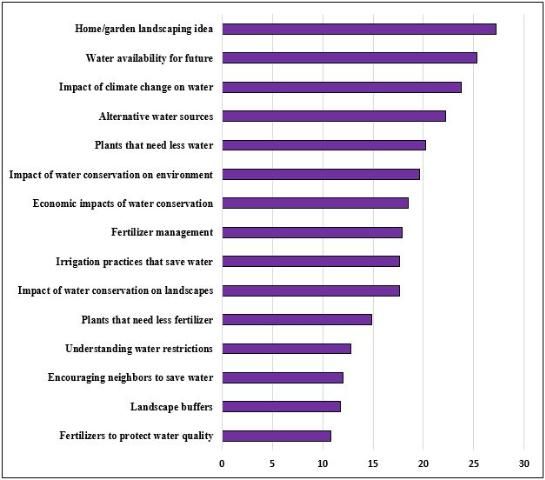
After indicating what they were interested in learning, respondents said how they wanted to learn about the topics listed above. The most popular option was through visiting a website, followed by watching TV coverage and watching a video. If Extension could put greater effort into developing and maintaining websites, it might extend the reach of the programs. Reading fact sheets and newspapers followed, and the least popular learning options were through synchronous education (i.e., workshops, seminars, webinars, etc.) and social media.
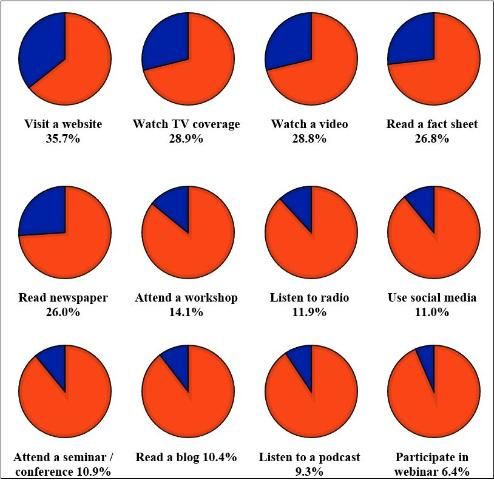
Conclusion
This publication presents highlights from a 2018 statewide survey of Florida citizens' landscapes and landscape management practices with recommendations for how to use the information. Extension professionals and other practitioners who work on landscape and water issues can use this information to meet the needs of their target audiences.
Acknowledgements
This research was supported by the University of Florida Center for Landscape Conservation and Ecology. We also thank several UF/IFAS faculty and staff members for reviewing early iterations of the survey instrument.
References
Borisova, T., Warner, L., Kipp Searcy, J., Kumar Chaudhary, A., & Dukes, M. D. (2017). Estimating benefits of outdoor water conservation: A step-by-step guide. FE1009. Gainesville: University of Florida Institute of Food and Agricultural Sciences. Retrieved from https://edis.ifas.ufl.edu/publication/fe1009
Community Associations Institute [CAI]. (2017a). Florida state summary. Community Association data and information. In Treese, C. J. (ed.) Community Association Fact Book. Foundation for Community Association Research, Fall Church, VA. Retrieved from https://foundation.caionline.org/publications/factbook/
Community Associations Institute [CAI]. (2017b). Statistical review 2017: Summary of key association data and information. In Treese, C. J. (ed.) Community Association Fact Book. Foundation for Community Association Research, Fall Church, VA. Retrieved from https://foundation.caionline.org/publications/factbook/
Lamm, A. J., & Lamm, K. W. (2019). The use of nonprobability sampling methods in agricultural and extension education research. Journal of International Agricultural and Extension Education, 26(1), 52–59. doi:10.5191/jiaee.2019.26105
University of Florida Institute of Food and Agricultural Sciences [UF/IFAS]. (2013). Shaping solutions for Florida's future: The University of Florida extension roadmap 2013–2023. University of Florida. Retrieved from https://pdec.ifas.ufl.edu/roadmap/FloridaExtensionRoadmap_2013-2023.pdf